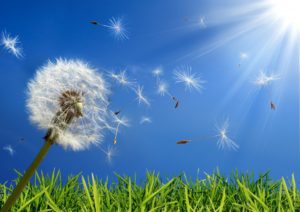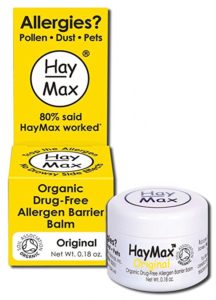I haven’t posted in several days because I was under the weather with a crazy virus that completely sapped my energy and had me doing nothing at all but trying to keep the room from spinning. It began with a sore throat and I was certain it was allergies. This is the time of year when my allergies are in full force. (Wow, this post sounds all complainy and poor me-ish, but bare with it. I’m taking it somewhere …)

Obviously, lots of people suffer from allergies. According to the Allergy and Asthma Foundation of America, researchers estimate that 50 million people in the U.S. have nasal allergies. And that population is increasing, they say. Allergy sufferers may miss days of work and school and miss out on recreational activities as well. And, of course, allergies can interfere with getting a good night’s sleep. There is no cure for allergies, but there are things you can do to ease your symptoms.

One of those things is to use HayMax Allergen Barrier Balm™ before bed. Created by Max Wiseberg, a lifelong allergy sufferer who was inspired to develop the balm when other allergy remedies didn’t work for him, HayMax Allergen Barrier Balm is a natural, organic balm that traps allergens when applied to the nostrils. “The trick to sleeping well when you suffer from hay fever is to reduce the amount of pollen getting into your body at night,” says Wiseberg. People can tolerate a certain amount of pollen without reaction, he adds, but once this amount is exceeded – called the trigger level – hay fever symptoms start to occur. Stay below this level at night, you won’t get the symptoms and your sleep won’t be affected. Go above it and that’s when the trouble starts.
Wiseberg regularly writes for newspapers, magazines and blogs on the subject of allergies and airborne allergens, and has appeared on TV and radio so he’s got cred. Below, he offers a few tips on how to avoid reaching that trigger level, allowing you to rest easy at night.
-
Keep bedding and fabrics clean. Vacuum the house regularly, especially beds and fabrics, such as bed covers and curtains, to remove pollen, dust and pet allergen particles. Wash bedding regularly to remove allergens and dry them indoors rather than on a clothes line to prevent pollen particles being blown onto them by the wind.
-
Keep the house closed from the outside world. Close windows and use an air conditioner, preferably with a HEPA (High Efficiency Particle Arresting) filter to capture pollen and dust particles, as well as cool and circulate the air.
-
Have a nightly routine before bed.Shower at night before sleeping to remove pollen particles and pet hair from your hair and body. Clear the nasal passages with water, or use a saline nasal spray, to clear pollen from the nose. Finally, apply an allergen barrier balm to the nostrils and around the bones of the eyes to trap pollen, dust and pet allergens before they enter the body.
-
Ensure that pets are well groomed. If you own a pet, shampoo it as much as possible to remove pet allergens and pollen particles, or ban it from the bedroom completely.
“Loss of sleep because of hay fever is very significant, as it can impact how a person functions the next day at school or at work,” Wiseberg says. “The effect of sleep deprivation on productivity and health costs companies billions of dollars each year.”
Want to try HayMax Allergen Barrier Balm? Get it here … or on Amazon.com by clicking the link below.
YOU MAY ALSO LIKE:
New and Noteworthy Beauty Products
A Doctor Answers Common Cold and Flu Questions
Eat These to Protect Your Skin